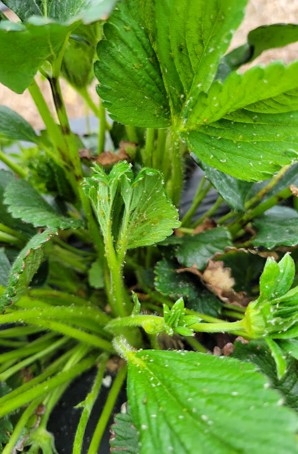Biology
A number of different aphid species feed on strawberries in North Carolina, including the strawberry aphid (Chaetosiphon fragaefolii), potato aphid (Macrosiphium euphorbae), and green peach aphid (Myzus persicae). In previous years, are occurances of Chaetosiphon minor and the yellow rose aphid (Rhodobium porosum) have been reported on strawberries in some parts of the state.
Most species have complex life cycles where they alternate between generations of parthenogenic ("self-cloning") females that give birth to live young, and generations of winged males and females that reproduce sexually. Immature aphids, called nymphs, are wingless and can go from birth to adulthood in less than two weeks so populations have the potential to increase rapidly. Fortunately, a wide variety of natural enemies eat aphids, so damaging infestations are very rarely an issue in North Carolina strawberries.
Damage
Small aphid populations can be exacerbated under covers used for freeze protection used during winter or early spring. Beware of any aphids present on your strawberries before placing the covers. At very high densities on young plant tissue, cause water stress, wilting, and reduced plant growth. The honeydew that aphids excrete can cause sooty mold growth on fruit that will render it unmarketable, but population densities high enough to cause this type of damage are rare in North Carolina.
Many aphids can vector viruses in strawberries. However, virus transmission is usually only problematic in perennial planting or nurseries, not in annual-grown strawberries.
Sampling
Aphids are most abundant in the underside of strawberry leaves and around the crown. To sample for aphids, collect 40 randomly-selected leaves per acre. Inspect the leaves and count how many are infested with wingless and non-parasitized aphids. Visibly parasitized aphids appear brown, swollen, and dry, and have already been killed by a parasitoid wasp that developed inside them. Specific economic thresholds for North Carolina have not been established, but work in California indicates that infestation rates of above 30% are necessary to justify insecticide applications.
Management
Conventional
Systemic and foliar applied materials can be used against aphids in strawberries. Care must be taken when applying these materials to avoid harming bees. Beware that pyrethroids may exacerbate aphid infestations due to non-target effects on aphids' natural enemies. Refer to the North Carolina Agricultural Chemicals Manual for materials recommended for use against aphids in North Carolina and the Southern Region Small Fruit Consortium Strawberry IPM Guide for regional recommendations.
Organic
OMRI approved insecticidal soaps are available for controlling aphids. Overuse of insecticidal soap can damage strawberry plants. Refer to the North Carolina Agricultural Chemicals Manual for materials recommended for use against aphids in North Carolina and the Southern Region Small Fruit Consortium Strawberry IPM Guide for regional recommendations.
Biological
Aphids are frequently kept under control by numerous predatory insects including: parasitoid wasps, syrphid fly larvae, lacewing larvae and lady beetles and their larvae. These predators occur naturally around strawberry fields, and purchasing additional predators is usually not necessary or cost effective.
More Information
What to watch for: Aphids in strawberries
North Carolina Agricultural Chemicals Manual
Strawberry IPM Guide - Southern Region Small Fruit Consortium
Publication date: May 15, 2014
Reviewed/Revised: March 20, 2025
N.C. Cooperative Extension prohibits discrimination and harassment regardless of age, color, disability, family and marital status, gender identity, national origin, political beliefs, race, religion, sex (including pregnancy), sexual orientation and veteran status.




